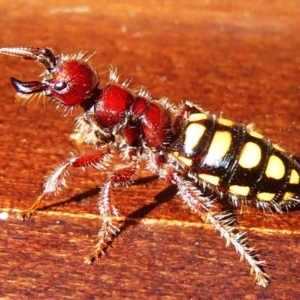Smooth flower wasp at Barragga Bay, NSW
Identification history
| Catocheilus sp. | 26 Nov 2017 | KimPullen | ||
| Unidentified | 26 Nov 2017 | narelle |
Identify this sighting
Please Login or Register to identify this sighting.
User's notes
Its about 1.8 cm long
6 comments
narelle
wrote:
27 Nov 2017
Hi Kim, Do they sting ? At first I thought "What a lovely striking bug" and went to photograph it. Then suddenly I thought it may be a European Wasp, and that I should kill it, but I couldn't see a sting . It was cleaning itself and suddenly stopped still when I came near. I was a bit scared but then it seemed to relax and start cleaning itself .again.
KimPullen
wrote:
28 Nov 2017
Yes Narelle, they do sting, although I've never heard of anyone being stung by one. Another wasp in the same family, the so-called 'Blue ant', has a notorious sting. As with all Hymenoptera (ants, bees and wasps), it is only the female that can sting.
narelle
wrote:
29 Nov 2017
Ahh .. Very interesting . So this one is a female, but I couldn't see a sting, ? I thought that all the bullants I see do have stings, Either they are all females or their pointy bums just look like stings. ?
KimPullen
wrote:
30 Nov 2017
The sting in all ants, bees and wasps is usually retracted inside the abdomen, and only comes out when they want to use it, either to defend themselves or to kill or paralyse a prey animal (usually another insect or a spider) to feed their offspring. In most bees and wasps, males and females look fairly similar, but smooth flower wasps (such as this Catocheilus) are exceptional in that the females are wingless. Ants are different again in that they have three 'castes' - winged fertile males, winged fertile females (queens) and wingless sterile females (workers). Normally the only ants we see are the workers; the males and virgin queens only emerge from the nest periodically (often before rain) in swarms that fly into the air, mate and disappear, the mated queens to form new colonies. Not all ants sting, bullants as we know being one kind that does.
Please Login or Register to comment.
Nearby sightings
Location information
- Coordinates 150.055545-36.506885
- Places Barragga Bay, NSW
Sighting information
- 1 Abundance
- 26 Nov 2017 09:34 AM Recorded on
- narelle Recorded by
Species information
- Catocheilus sp. (genus) Scientific name
- Smooth flower wasp Common name
- Not Sensitive
- Local native
- Non-Invasive
- Up to 648m Recorded at altitude
- Machine learning
- External link More information









































